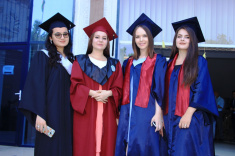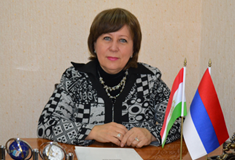Вестник РТСУ
Ходжаева Н.Дж. История изучения авестийских гидронимов и оронимов в период с XIX по XX вв.
УДК [902+91:413.11] (584)
ИСТОРИЯ ИЗУЧЕНИЯ АВЕСТИЙСКИХ ГИДРОНИМОВ И ОРОНИМОВ
В ПЕРИОД С XIX ПО XX ВЕКА
Ходжаева Наргис Джомиевна
Кандидат исторических наук,
научный сотрудник Национального музея древностей Таджикистана
Институт, истории, археологии и этнографии им. А.Дониша
Академии наук Республики Таджикистан
Ул. Акад. Раджабовых 7, Душанбе 734025, Республика Таджикистан
Тел.: (+992 37) 227 25 54; 221 37 42; (+992) 918 64 91 85 (м.)
rangha@mail.ru
На основе анализа научной литературы автор предлагает выделить три периода истории изучения авестийских гидронимов и оронимов.
Ключевые слова: Авеста; гидроним; ороним; периодизация.
Литература
1. Абаев В.И. Скифский быт и реформа Зороастра // Archiv Orientalni. – 1956. – XXIV. – C. 23-56.
2. Вайнберг Б.И. Этногеография Турана в древности. VII в. до н.э.-VIII в.н.э. – М.: Издат. фирма «Восточная литература», 1999. – 359 с.
3. Массон В.М. Еще раз о геродотовской реке Акес // Эллинистический Ближний Восток, Византия и Иран. – М.: Наука, 1967. – С.172-175.
4. Массон М.Е. Ахангаран. Археолого-топографический очерк. – Ташкент: Изд-во АНУзССР, 1953. – 144 с.
5. Пьянков И.В. Река Ох и Арьяна Вайджа // Бактрия-Тохаристан на древнем и средневековом Востоке. Тез. докл. конф. посвященной десятилетию Южно-Таджикской экспедиции.– М.: Наука, 1983. – С. 66-67.
6. Пьянков И.В. Зорастр в истории Средней Азии: проблема места и времени (опыт исторической реконструкции)// Вестник древней истории, 1996. – №3. –С.3-23.
7. Пьянков И.В. Древние цивилизации Евразии. История и культура // Материалы Междунар. науч. конф., посвящ. 75-летию Б.А.Литвинского (Москва, 14-16 окт. 1998 г.). – М.: Изд-ая фирма «Вост. Лит-ра», 2001. – С. 334-348.
8. Ртвеладзе Э.В. Газаба-Гозбон // История материальной культуры. – 1999. – Вып. 30. – С. 104-109.
9. Tolstov S.P. On ancient delta of the Oxus and Yaxartus. – М.: Publishing House «Vost. lit», 1962. – 352 с.
10. Steblin-Kamensky I.M. The river of iranianancestral home // The onomastics of Middle Asia. – М.: Nauka, 1978. – P. 72-74.
11. Bartholomae Chr. Altiranisches Wörterbuch. –Srassburg, 1904. – 2000 p.
12. Boyce M. A History of Zoroastrianism. Vol.I. – Leiden-New-York-Kopenhavn-Køln, 1975. – 347 p.
13. Boyce M., Grenet F. A History of Zoroastrianism. Vol. II. – Leiden-New-York-Kopenhavn-Køln, 1991. – 596 p.
14. Christensen A. Le premier chapitre du Vendidad et l’histoire primitive des tribus iraniennes. – København, 1943. – 92 p.
15. Eilers W. Der Name Demawend // Archiv Orientalni. – 1954. – № 22. – P. 267-374.
16. Geiger W. Ostīrānische Kultur im Altertum. – Erlangen, 1882. –Р.176-216.
17. Gnoli G. Zoroaster’s Time and Homeland. A Study on the Origins of Mazdeism and Related Problems. – Naples, 1980. – 279 p.
18. Gershevitch I. The Avestan Hymn to Mithra. – Cambridge, 1959. – 357 p.
19. Grenet F. Bāmiyān and the Mihr Yašt // Bulletin of the Asia Institute. – 1993. – Vol. 7. – P.87-94.
20. Grenet F. Zoroastre au Badakhshān // Studia Iranica. – 2002. – T.31, fascicule 2. – P. 199-202.
21. Grenet F. An Archaeologst’s Approach to Avesta Geography // Birth of the Persian Empire. Vol. I / Ed. by V.S.Curtis and S. Stewart. – London, New-York: I.B.Tauris, 2005. –Р.35-36.
22. Herzfeld E. Zoroaster and his World. Vol. I-II. – Princeton, 1947. – 851 p.
23. Humbach H. The Gāthās of Zarathushtra and Other Old Avestan Texts. P.I: Introduction, Text and Translation. – Heidelberg, 1991. – P. 24-27.
24. Kellenz J. Zoroastre et l’Avesta ancient. – Louvain, 1991. – 70 p.
25. Kellenz J. Le panthéon de l’Avesta ancien. – Wiesbaden, 1994. – 159 p.
26. Lommel H. Anahita-Sarasvaiti // Asiatica. – Lepzig, 1954. – P. 405-413.
27. Marquart J. Erānšāhr nach der Geographie des Ps. Moses Xorenaci. – Berlin, 1901. – 358 р.
28. Markwart J. Vehrot und Arang. – Leiden, 1938. – 202 р.
29. Markwart J. A Catalogue of the Provincial Capitals of Ērānshahr (Pahlavi Text, Version and Commentary) / Ed. by G.Messina. – Roma, 1931. – 120 р.
30. Monchi-Zadeh D. Topographisch-historische Studienzum iranischen Nationalepos. – Wiesbaden, 1975. – 309 р.
31. Nyberg H.S. Biographie de Zaratuštra dans le Denkart // Acta Iranica 7. – 1975. – Vol. IV. – P. 510-518.
32. SkærvøP.O. The Avesta as source for the early history of the Iranians // The Indo-Aryans of Ancient South Asia. Language, Material Culture and Ethnicity / Ed. by G. Erdosy. – Berlin-N-Y., 1995. – 155-176.
33. Stein A. Afghanistan in Avestic geography // IAnt. – 1886. – № 15. – P. 21-23.
34. The Zend-Avesta. Part II. The Yasna, Visperad, Sîrôzahs, Yasts, Nyâyis / Transl. by J.Darmesteter. – Oxford, 1883 (The Sacred Books of the Eest. Vol. XXIII). – 384 p.
35. Tomaschek W. Zur historischen Topographie von Persian, I: Die Strassenzüge der Tabula Peutingeriana // Sitzungsberichte der Wiener Akademie der Wissenschaften. – 1883. – C.II. –Р.144-231.
HISTORY OF STUDIES OF AVESTAN HYDRONIMS AND ORONIMS DURING
THE 19th – 20th CENTURIES
Hodzhayeva Nargis Dzhomiyevna
Candidate of Historical Sciences,
Researcher of the National Museum of Antiquities of Tajikistan
A. Donish Institute of History, Archaeology and Ethnography
Academy of Sciences Republic of Tajikistan
Acad. Rajabov 7, 734025 Dushanbe, Republic of Tajikistan
Ph.: (+992 37) 227 25 54; 221 37 42; (+992) 918 64 91 85 (m.)
On the basis of the analysis of scientific literature, the author suggested to single out three periods in history to study Avestan hydronims and oronims.
Keywords: Avesta; hydronim; oronim; periodization.
References
1. Abaev V.I. The Scythian way of life and the reform of Zoroaster // Archiv Orientalni. – 1956. – XXIV. – P. 23-56.
2. Vainberg B.I. Ethnogeography of Turan in ancient times. 7th c. B.C. -8th A.D. – М.: Publishing House «Vostochnaya lit.», 1999. – 359 p.
3. Masson V.M. Again about the Herodotus river Akes // Hellenistic Middle East, Byzantine Empire and Iran. – М.: Nauka, 1967. – P.172-175.
4. Masson V.M. Ahangaran. Archaeological and topographical essay. – Tashkent: Pablishing House AS UZSSR, 1953. – 144 p.
5. Pyankov I.V. The river Ох and Aryana-Vaega // Bactria-Tokharistan in ancient and early medieval East. – М.: Nauka, 1983. – P. 66-67.
6. Pyankov I.V. Zoroaster in the history of Middle Asia: the problem of place and time (trial of historical reconstruction) // Vestnik Drevnei Istorii, 1996. – № 3. –Р.3-23.
7. Pyankov I.V. Ancient civilizations of Euroasia. History and culture / The materials of international conference dedicated the 75th anniversary of B.A.Litvinsky (Moscow, 14-16 oct. 1998). – М.: Publishing House «Vost. lit», 2001. – P. 334-348.
8. Rtveladze E.V. Gazaba-Gozbon // Institute of material culture of Uzbekistan. – 1999. – Issue. 30. – P. 104-109.
9. Tolstov S.P. On ancient delta of the Oxus and Yaxartus. – М.: Publishing House «Vost. lit», 1962. – 352 с.
10. Steblin-Kamensky I.M. The river of iranianancestral home // The onomastics of Middle Asia. – М.: Nauka, 1978. – P. 72-74.
11. Bartholomae Chr. Altiranisches Wörterbuch. –Strasburg, 1904. – 2000 col.
12. Boyce M. A History of Zoroastrianism. Vol.I. – Leiden-New-York-Kopenhavn-Køln, 1975. – 347 p.
13. Boyce M., Grenet F. A History of Zoroastrianism. Vol. II. – Leiden-New-York-Kopenhavn-Køln, 1991. – 596 p.
14. Christensen A. Le premier chapitre du Vendidad et l’histoire primitive des tribus iraniennes. – København, 1943. – 92 p.
15. Eilers W. Der Name Demawend // Archiv Orientalni. – 1954. – № 22. – P. 267-374.
16. Geiger W. Ostīrānische Kultur im Altertum. – Erlangen, 1882. –Р.176-216.
17. Gnoli G. Zoroaster’s Time and Homeland. A Study on the Origins of Mazdeism and Related Problems. – Naples, 1980. – 279 p.
18. Gershevitch I. The Avestan Hymn to Mithra. – Cambridge, 1959. – 357 p.
19. Grenet F. Bāmiyān and the Mihr Yašt // Bulletin of the Asia Institute. – 1993. – Vol. 7. – P.87-94.
20. Grenet F. Zoroastre au Badakhshān // Studia Iranica. – 2002. – T.31, fascicule 2. – P. 199-202.
21. Grenet F. An Archaeologst’s Approach to Avesta Geography // Birth of the Persian Empire. Vol. I / Ed. by V.S.Curtis and S. Stewart. – London, New-York: I.B.Tauris, 2005. –Р.35-36.
22. Herzfeld E. Zoroaster and his World. Vol. I-II. – Princeton, 1947. – 851 p.
23. Humbach H. The Gāthās of Zarathushtra and Other Old Avestan Texts. P.I: Introduction, Text and Translation. – Heidelberg, 1991. – P. 24-27.
24. Kellenz J. Zoroastre et l’Avesta ancient. – Louvain, 1991. – 70 p.
25. Kellenz J. Le panthéon de l’Avesta ancien. – Wiesbaden, 1994. – 159 p.
26. Lommel H. Anahita-Sarasvaiti // Asiatica. – Lepzig, 1954. – P. 405-413.
27. Marquart J. Erānšāhr nach der Geographie des Ps. Moses Xorenaci. – Berlin, 1901. – 358р.
28. Markwart J. Vehrot und Arang. – Leiden, 1938. – 202 р.
29. Markwart J. A Catalogue of the Provincial Capitals of Ērānshahr (Pahlavi Text, Version and Commentary) / Ed. by G.Messina. – Roma, 1931. – 120 р.
30. Monchi-Zadeh D. Topographisch-historische Studienzum iranischen Nationalepos. – Wiesbaden, 1975. – 309 р.
31. Nyberg H.S. Biographie de Zaratuštra dans le Denkart // Acta Iranica 7. – 1975. – Vol. IV. – P. 510-518.
32. SkærvøP.O. The Avesta as source for the early history of the Iranians // The Indo-Aryans of Ancient South Asia. Language, Material Culture and Ethnicity / Ed. by G. Erdosy. – Berlin-N-Y., 1995. – 155-176.
33. Stein A. Afghanistan in Avestic geography // IAnt. – 1886. – № 15. – P. 21-23.
34. The Zend-Avesta. Part II. The Yasna, Visperad, Sîrôzahs, Yasts, Nyâyis / Transl. by J. Darmesteter. – Oxford, 1883 (The Sacred Books of the Eest. Vol. XXIII). – 384 p.
35. Tomaschek W. Zur historischen Topographie von Persian, I: Die Strassenzüge der Tabula Peutingeriana // Sitzungsberichte der Wiener Akademie der Wissenschaften. – 1883. – C.II. –Р.144-231.
-
- Управление науки и инноваций
- Вестник РТСУ
- Научные направления университета
- Научно-исследовательские проекты
- Публикационная активность
- Публикация преподавателей РТСУ
- Молодые ученые
- Научно-исследовательская работа студентов
- Открытые международные студенческие Интернет-олимпиады















